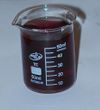Difference between revisions of "Potassium ferrate"
(→Chemical) |
|||
| Line 81: | Line 81: | ||
Potassium ferrate solutions can just be poured into the ground or drain. Contact with any organics causes the ferrate to be quickly reduced and decomposed. | Potassium ferrate solutions can just be poured into the ground or drain. Contact with any organics causes the ferrate to be quickly reduced and decomposed. | ||
| + | [[Category:Chemical compounds]] | ||
| + | [[Category:Inorganic compounds]] | ||
[[Category:Potassium compounds]] | [[Category:Potassium compounds]] | ||
[[Category:Ferrates]] | [[Category:Ferrates]] | ||
[[Category:Oxidizing agents]] | [[Category:Oxidizing agents]] | ||
[[Category:Unstable materials]] | [[Category:Unstable materials]] | ||
Revision as of 20:02, 4 August 2015
| |||
| Names | |||
|---|---|---|---|
| IUPAC name
Potassium ferrate
| |||
| Systematic IUPAC name
Potassium ferrate (VI) | |||
| Properties | |||
| K2FeO4 | |||
| Molar mass | 198.04 | ||
| Appearance | Dark purple crystals | ||
| Odor | None | ||
| Soluble | |||
| Except where otherwise noted, data are given for materials in their standard state (at 25 °C [77 °F], 100 kPa). | |||
| Infobox references | |||
Potassium ferrate is a compound with a formula of K2FeO4. This is an unstable potassium salt of ferric acid, which itself is too unstable to exist in aqueous solution. It is a dark purple crystalline solid that dissolves to form a reddish-purple solution. This solution is stable at high pH, but at neutral or lower pH, the ferrate decomposes, liberating oxygen.
Potassium ferrate is a very strong, but relatively mild oxidizer.
Contents
Properties
Physical
It is a dark purple crystalline solid that dissolves to form a reddish-purple solution. Its solubility in water is limited, which makes potassium ferrate the most practical ferrate: it is soluble in water, unlike the insoluble barium ferrate, but relatively easy to crystallize out of the solution, unlike the very soluble sodium ferrate which is particularly hard to isolate as a solid salt.
Chemical
It is a very potent oxidizer. It oxidizes primary alcohols to carboxylic acids, chlorates to perchlorates, ammonia to nitrogen, nitrites and nitrates. It is not known whether it is capable of oxidizing bromate to perbromate.
At high pH, the oxidizing strength of ferrate is relatively low, and the ferrate itself can be prepared with weaker oxidizers such as hypochlorites and bromine. At low pH, the full oxidizing power of ferrate is revealed.
Availability
There is a growing market for potassium ferrate as a practical and ecologically friendly water purificant. As such, it can be bought from certain companies.
Preparation
There are several methods of ferrate synthesis. The most practical are the electrolytic method and the hypochlorite method. In the electrolytic method, a solution of potassium hydroxide is electrolyzed with iron electrodes. In the hypochlorite method, salts of trivalent iron are oxidized with hypochlorites in solution.
In any case, preparing a solution of potassium ferrate isn't very hard, but crystallization of the stable pure salt is. The trick is to quickly crystallize the ferrate, filter, dissolve in a solution of potassium hydroxide, recrystallize, filter and dry very quickly, because the impure compound decomposes on the fly. Vacuum filtering through sintered glass is mandatory, because ferrate oxidizes filter paper. Ice-cold anhydrous ethanol or diethyl ether is recommended for washing the crystals.
Handling
Safety
Potassium ferrate is non-toxic. The products of its decomposition aren't toxic either. However, dry potassium ferrate should not come in contact with flammable organic compounds.
Storage
Potassium ferrate should be stored in a dark place, without access to air (it reacts with carbon dioxide in the air). Ideally, it should be kept under vacuum or inert gas.
Disposal
Potassium ferrate solutions can just be poured into the ground or drain. Contact with any organics causes the ferrate to be quickly reduced and decomposed.

